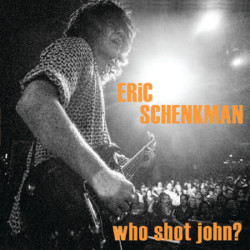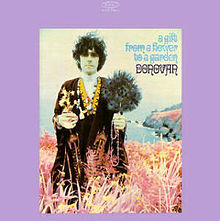Eric Schenkman Puts a New Spin on the Blues
There are two clear sides to guitar maestro Eric Schenkman. By day, Eric makes his bones as lead guitarist in the revitalized and still very much active Spin Doctors, who dominated the early-’90s with clever alt-rock tentpoles he co-wrote including “Little Miss Can’t Be Wrong,” “Two Princes,” “Cleopatra’s Cat,” and “You Let Your Heart Go Too Fast.” By night — just about every Wednesday night, in fact — you can find Schenkman and his own band playing the blues fierce and strong at Grossman’s Tavern in his native Toronto.
Schenkman recently put his finely honed blues-centric chops front and center on his just-released solo album Who Shot John? (VizzTone), ostensibly named after a euphemism that essentially means cut the crap. (Feel free to substitute a harsher four-letter word at the end of that phrase as you see fit.) Indeed, Schenkman lets his blues flag fly quite high on Who Shot John?, ranging from the gnarly tone that drives “Lincoln’s Feat,” the loping down-home textures permeating “No Pain,” and the distorted duende muscle of the album-closing “Agent Orange Blues.”
“I do think there’s a little bit of blues in everything that you hear on there,” admits the guitarist/vocalist, “but none of the tunes are exactly the same kind of song either. It’s a cross-section of where I’m at.” His shrewd gear choices on the live stage have led to many great sounds on the album itself. “Live, I usually play a Gibson guitar and run it straight into mid-’60s Fender Bassman on a 2x12 cabinet without the back on it, if I can. I don’t use much more than that,” Schenkman reports. “It comes across as nice and clean, and you can hear the string. It’s important in the blues to be able to hear the string. Part of it is really being able to hear the wire, you know?”
Schenkman, 55, called me from his homebase in Toronto to discuss the creative process behind Who Shot John?, his inherent audiophile tendencies when it comes to vinyl playback, and where he currently fits in on the “totem pole” of visionary musicianship. It’s a sign of the times, got to learn to carry on . . .
 Mike Mettler: Considering the live-off-the-floor feel in evidence all throughout this album, it’s nice to learn Who Shot John? was pretty much cut with all of the musicians in the same room.
Mike Mettler: Considering the live-off-the-floor feel in evidence all throughout this album, it’s nice to learn Who Shot John? was pretty much cut with all of the musicians in the same room.
Eric Schenkman: Everything survived — all the live-off-the-floor guitar and drums stuff. The garage for [drummer] Van Romaine’s house is connected to his kitchen, and we had the doors open when he was in the garage while I was in the kitchen. We were looking sideways at each other through the open door, with no window or anything. (chuckles)
And then Cody [Dickinson, of the North Mississippi Allstars], he’s in the other corner with his electric washboard and all his other stuff, and we were looking at each other through a tiny little window.
Mettler: That kind of direct eye contact lends to a more intuitive way of knowing where you’re going while you’re playing, thanks to that connection.
Schenkman: It’s whatever you need to have it be that way. For me, it really makes a difference for the stuff to feel immediate, and expressive. When I spend too much time trying to, say, produce the performance of it — it’s all relative to how well I know the material. I can do that if I know the material super, super well, but if I don’t, I’m going to try and catch it live off the floor.
This record really responds to that. It’s better with the stuff I spent a little bit more time on. Everything was cut live off the floor, in one way or another. “Lincoln’s Feat” is a good example of that. We did the guitar and vocal together, and then we added [Shawn Kellerman’s] bass and the piano. It’s the four of us guys, with one track each [i.e., one each for Eric, Shawn, Cody, and Van].
Mettler: You get this really nice, gnarly, Billy Gibbons-like tone on that song.
Schenkman: Oh, man — that’s a ’65 DeArmond pickup on a Telecaster. It’s beautiful-sounding.
Mettler: I like some of the odd meters and hard stops you throw in there, and I especially like the wild turnaround you have in “Fortune Teller.”
Schenkman: Yeah, it’s that 20-bar blues, and then you get that turnaround — exactly.
Mettler: Those twists put you in a different position in the “Refrigerator Car,” so to speak. That one’s always been a favorite of mine. [“Refrigerator Car” is a key track on the Spin Doctors’ 1991 debut album, Pocketful of Kryptonite.]
Schenkman: Yeah, I’m definitely a different position in the old “Refrigerator Car,” no doubt. Yeah, we’ll play that song — not on my gig, but the Spin Doctors will. And the Doctors are sounding really great these days too.
I rarely do any Doctors songs with my thing [in Toronto], though. We do one ballad called “Indifference,” which I sang on the Spin Doctors’ second record [1994’s Turn It Upside Down]. The Spin Doctors don’t do that song all that much, and I tend to keep those things separate. I even play different guitars. I play a Flying V with my thing, and I’ll play an SG with the Spin Doctors. I sing more with my thing, but, yeah, I love ’em both.
Mettler: You’re working both sides of the same coin. One thing I wanted to check — back in the early Spin Doctors days, you had that weird custom amp called The Hourglass. Do you still have it? Does it still exist?
Schenkman: I have two of them, actually, and both are in my basement. Both of them are early-’70s Fender Twins, and we just switched them with good transformers. My guitar tech Rich knew about the circuits from the old ’50s Fenders, and he’d take the tremolo from one of the old Twins and make that into a Presence knob. The way he set out the EQ made it sound more like a vintage Twin amp. With the Doctors now, I use two Vox AC30s, and with my thing, I use a Fender Bassman or a Tremolux, depending on how big the room is.
Mettler: I’ve always loved the super-clean tone you got on “Forty or Fifty” [another key track on Pocketful of Kryptonite] with the Hourglass.
Schenkman: “Forty or Fifty” was done with my old Stratocaster, and it’s the one I wrote all those songs on, and about the only song I actually played it on. I remember doing it through a Vox amp, which I also never use, if I remember it correctly.
Mettler: Back to Who Shot John? — I also like the vocal-effects choice on the Track 10 lead-out, Agent Orange Blues,” which gives it a different feel than most of the rest of the album.
Schenkman: It is kind of pushed and all distorto, yeah. It’s a sonic landscape, for sure. It’s hill country and punk blues, all rolled into one.
Mettler: Cody Dickinson’s electric washboard textures on the song “Who Shot John?” are the perfect addition to the vibe you’ve got going on there. It’s funny — I wrote “washboard abs” in my notes next to my comments about that title track, which is kind of a Freudian slip there, I realize now. . . (chuckles)
Schenkman: (laughs) I’ve been meaning to work with Cody Dickinson for a long time now, and that’s initially how it happened. I had that tune, the title track, and I always loved Cody’s washboard playing. I called him up and said, “I want you to play washboard on this song,” and he said, “I haven’t played electric washboard in some time.” So I said, “Well, can you get it out, ” (chuckles heartily)
Mettler: It totally fits in with the shifting of the reggae-ska groove you’ve got going on there.
Schenkman: It’s sort of like zydeco without the accordion, really. That’s probably how they got ska in the first place. The last two tracks on Side 1 are “washboard active” — “Who Shot John?” and “No Pain.” It was great fun working with those guys, yeah.
Mettler: I also like that double- or triple-tracked vocal on “No Pain,” where you’re just barely a millisecond behind on the answer part.
Schenkman: Yeah, there’s actually a lot of me on that song.
Mettler: Every track here screams out for putting the needle into the groove on vinyl, I have to say.
Schenkman: (laughs) That’s great to hear. Yeah, vinyl is something I’ve always liked. And I’ve always had a turntable, so vinyl is something I’ll always make if I can. I can’t help myself. And when I found out the record company could make it any color I wanted, I knew right away what I wanted to do. It had to be peach-orange vinyl.
Mettler: That’s perfect! It should have those orange swirls that fade away after every spin. (both laugh) Since we both grew up in a vinyl-listening era, I’m sure it must feel great to be able to put an album out that way. While we’re still on the vinyl tip, what was the first record you got as a kid that had impact on you? Was it something you got up in Canada? Where did you start your record-buying?
Schenkman: Well, my old man had a lot of records, so there were records around me before I knew what records were. I was equally attracted to the stereo and the records. My dad had a big record collection, and there are pictures of me actually tinkering with the stereo — which I still have.
My dad was an audiophile, and he was the kind of audiophile who was always turning over his equipment, so I have a lot of the gear he was “done” with — the old Dynaco-Dynakit stuff that he bought, and the old Thorens turntable that he replaced with some more modern thing. So, yeah, I love vinyl.
The first records I remember . . . (slight pause) you know, it’s funny. We had a red vinyl of “(How Much Is) The Doggie in the Window?” [the Bob Merrill song recorded by Patti Page and released on a dark/wine crimson-labeled 45 on the Mercury label in January 1953.] We had that when I was like 2 years old, because we always had records around.
But the first contemporary records we had — I remember my old man bringing back a bunch of Beatles records, which would have been right after Magical Mystery Tour came out [on November 27, 1967]. He was always bringing back records that had any kind of “cool” arrangements, like any of George Martin’s stuff, or the Frank Zappa kinds of things — anything that was the least bit orchestral or well-arranged like that stuff, he had that on vinyl.
 I had a lot of records at my disposal that way, so I remember Magical Mystery Tour very clearly as an early record, and also that Donovan double record, A Gift From a Flower to a Garden [released in December 1967].
I had a lot of records at my disposal that way, so I remember Magical Mystery Tour very clearly as an early record, and also that Donovan double record, A Gift From a Flower to a Garden [released in December 1967].
Mettler: Oh yeah — that Donovan one has a pretty cool album cover on it too.
Schenkman: Yeah! Very cool album cover! It’s got Donovan on the cover, and a weird, solarized, peacock-looking picture on it.
Mettler: A very “of-era” kind of cover, we can call it.
Schenkman: Yeah! And this is a good topic, because it’s so tactile and visual, and very connotative. I still remember that Donovan cover to this day, and that copy is still probably in my house. I can see everything about it in my mind as we’re talking about it. It was right from that kind of magical music period.
And then all the records from that time that you’d think I’d have, I had. When I moved to New York in 1985, I ended up learning this huge R&B catalog — this whole other repertoire of soul music that I had never heard of before — after I joined a band there. I also got the second-line stuff I learned when I was playing in a zydeco band for a while. I actually have the records people have given me from all of those different projects: “Hey man, learn this!” (chuckles)
Mettler: Like you said, you’ve probably still got most of them at home too. Are you using that vintage Thorens turntable to play your vinyl on today?
Schenkman: Yeah, Yeah, I’ve got ’em all, and I still listen to that stuff,. It’s like a 1959 Thorens turntable [most likely from the TD series of the time], and my dad had a special counterweight put on it. It even has the 16-speed on it, and everything.
Mettler: That’s about as vintage as you can get. What speakers are in your playback system?
Schenkman: Presently, I have a pair of AR speakers. I also have an AR turntable downstairs, but it’s broken. It was my mother’s, and that turntable is interesting, because you can play records backwards on that one [likely the XA model].
I also have another pair of speakers from England that are cylindrical, which have some really expensive English tweeters the BBC used to use. I was asking the guy at Ring Audio in downtown Toronto what speakers would go best with my Dynaco 70-watt amp, the ST-70A, and my Dynaco preamp, which is circa the late-’60s. The old man built those Dynakits and moved on from there, but I always liked those Dynaco-Dynakits. It’s got separate bass and treble controls for each side, and a really awesome high-pass filter.
Mettler: I can relate. I have a lot of vintage gear stored in boxes in my basement, like an old quad decoder and two Akai reel-to-reel players, just in case I ever need to get any of it out and set it up for listening purposes.
Schenkman: Yeah, I recognize that behavior. (both laugh) That’s good stuff. And I’ve got it worse in a way, because I also deal with collecting guitar amps and other gear. You gotta really decide what you like in this world, or you weed it down — otherwise, you need extra room in your house.
This is what happens to pianos and organs, because they take up so much room. I had to give away a really nice Lowrey organ with a Magic Genie [M-124 Twin 88] two-speed Leslie speaker, the full-on everything. It was a beautiful-sounding rig, but there was no place to put it. It’s now at the club I always play at, but nobody ever uses it. You’d have to come in real early and put in a whole bunch of work to get it to play right. Some stuff has just been outmoded a little bit in our world. Maybe you just have to rent a museum to house all that gear.
Mettler: We might just have to do that! Finally, I went back into my files to find an interview about the Spin Doctors we did together in November 1992. I asked you about where you thought your playing style came from, and you said, quote, “It’s like I’m sitting on a totem pole, carved in above the roots of incredible music made by people like Wes Montgomery, [Jimi] Hendrix, Duke Ellington, Miles Davis, and even Bartók. I don’t consciously try to sound like anybody else. I build from other people’s inspiration.” Not bad for looking at both sides of the hourglass that early on in your career, I’d say.
Schenkman: (chuckles) Wow, well, that’s pretty good, man! I’ve always been kind of a playlist guy, and I was probably listening to all of the names I used there specifically at that time. I do remember having this long Bartók phase. My dad had given me a 3CD Bartók box set — a lot of the string material, the folk dances, and the stuff where they play the sh-- out of the fiddle. [Béla Bartók was a Hungarian composer and pianist considered to be one of the most important composers of the 20th century.]
Yeah, you just brought me back there. I was probably listening to a lot of Wes then too. I was listening to a lot of stuff then to really try and push my brain — though I try to push my brain less now. (both chuckle)
I guess the biggest difference between me then and me now is I’m more physical than cerebral. I’m more physically carved into that totem pole now. And I’m trying to move as much as I can, because if you’re permanently in that position on the totem pole, you can’t get out. My point is, once you’re like petrified wood on a totem pole, you can’t move anymore. And I want to keep moving up.
When you’re young, you need your brain to expand, and as you get older, you need your body to stay fit so you can keep playing and keep singing. It’s an interesting point to make — really, really interesting. That’s the biggest difference. Otherwise, I totally agree with my former self. (chuckles)






























































